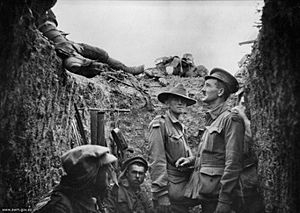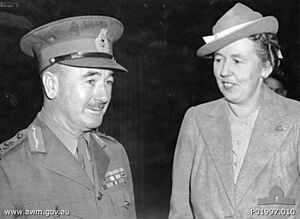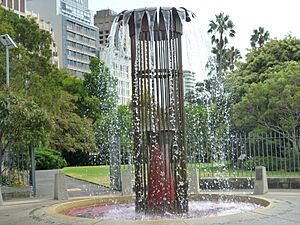Leslie Morshead facts for kids
Quick facts for kids
Sir Leslie Morshead
|
|
|---|---|
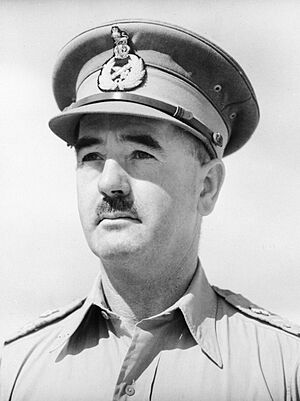
Leslie Morshead in 1941
|
|
| Nickname(s) | 'Ming the Merciless' |
| Born | 18 September 1889 Ballarat, Colony of Victoria |
| Died | 26 September 1959 (aged 70) Sydney, Australia |
| Allegiance | Australia |
| Service/ |
Australian Army |
| Years of service | 1913–1946 |
| Rank | Lieutenant general |
| Service number | NX8 |
| Commands held | I Corps (1944–45) Second Army (1944) New Guinea Force (1944) II Corps (1943) 9th Division (1941–43) 18th Infantry Brigade (1939–41) 5th Infantry Brigade (1937–39) 15th Infantry Brigade (1934–36) 14th Infantry Brigade (1933) 36th Infantry Battalion (1926–31) 19th Infantry Battalion (1921–25) 33rd Infantry Battalion (1916–19) |
| Battles/wars | |
| Awards | Knight Commander of the Order of the Bath Knight Commander of the Order of the British Empire Companion of the Order of St Michael and St George Distinguished Service Order Efficiency Decoration Mentioned in Despatches (8) Légion d'honneur (France) Virtuti Militari (Poland) Medal of Freedom (United States) |
| Other work | Teacher, farmer, manager of the Orient Steam Navigation Company |
Lieutenant General Sir Leslie James Morshead (18 September 1889 – 26 September 1959) was an Australian soldier, teacher, and businessman. He fought in both world wars. During the Second World War, he led Australian and British troops to important victories. These included the Siege of Tobruk (1941) and the Second Battle of El Alamein. His soldiers called him "Ming the Merciless" or "Ming" after a character from the Flash Gordon comics.
When the First World War began in 1914, Morshead joined the army as a private. He landed at Anzac Cove, Gallipoli in 1915. His group went farther than any other Australian unit that day. Later, he led the 33rd Infantry Battalion on the Western Front. He fought in battles like Messines and Passchendaele.
Between the wars, Morshead worked for the Orient Steam Navigation Company. He also stayed active in the part-time army, called the Militia. In 1939, he was chosen to lead the 18th Infantry Brigade. In 1941, he became commander of the 9th Division. He led this division during the famous Siege of Tobruk and the Second Battle of El Alamein. He returned to Australia in 1943. There, he led II Corps during the New Guinea campaign. In 1945, he commanded I Corps in the Borneo campaign.
Contents
Early Life and Education
Leslie Morshead was born on 18 September 1889 in Ballarat, Victoria. He was the sixth of seven children. His father, William Morshead, was a gold miner from Cornwall. His mother, Mary Eliza Morshead, was Australian-born. Leslie's father died when he was six years old.
He went to Mount Pleasant High School. In 1906, he became a junior teacher there. In 1909, he studied at the Melbourne Teachers Training College. After graduating in 1910, he taught in country Victoria. He taught at Tragowell and Fine View State School. In 1912, he moved to The Armidale School in New South Wales. In 1914, he moved to the well-known Melbourne Grammar School.
Morshead became a lieutenant in the Australian Army Cadets in 1908. At Armidale, he led the school's cadet unit. He also became a lieutenant in the Militia in 1913. He was promoted to captain in September. At Melbourne Grammar, he led a company in the school's cadet unit. There, he met Myrtle Catherine Woodside, who later became his wife.
First World War Service
Fighting at Gallipoli
The First World War started in August 1914. Morshead stopped teaching and joined the army. He joined the 2nd Infantry Battalion as a private. He became a lieutenant on 19 September. He sailed to Egypt in October 1914. He was promoted to captain in January 1915.
His battalion landed at Anzac Cove on 25 April 1915. This was a very important day for Australia. Morshead's group went further than any other Australian unit that day. They reached the slopes of Baby 700. But they were pushed back by Turkish soldiers. They fought off more attacks over the next few days. Morshead took command of C Company on 28 April.
He was promoted to major on 8 June. He showed great bravery in the Battle of Lone Pine on 6 August. The fighting was so fierce that he was the only officer in his battalion not hurt. However, in September, he got sick with dysentery. He was sent to a hospital in England. For his actions in the Gallipoli campaign, he was mentioned in official reports.
On the Western Front
Morshead returned to Australia in January 1916 to recover. After he got better, he joined the 33rd Infantry Battalion. He became its commander on 16 April. He was promoted to lieutenant colonel three days later. He sailed to England with his battalion in May 1916.
The 33rd Infantry Battalion trained in England. In November 1916, they went to France. They took over a quiet section of the Western Front. Morshead was mentioned in reports again. He also received the Distinguished Service Order. His commander praised his leadership and organization. He said Morshead's battalion was very efficient.
An official historian described Morshead as a "dapper little schoolmaster." He was only 28 years old. He was known for being very strict but fair. He made his battalion one of the best.
Morshead led the 33rd Infantry Battalion in the Battle of Messines in June 1917. He also led them in the difficult Battle of Passchendaele in October. In March 1918, his division helped stop the German Spring Offensive. His battalion helped hold the line near Villers-Bretonneux. On 4 April, they helped stop the Germans from taking the town. Morshead was later injured by poison gas. He returned to his unit in June.
He led the 33rd Infantry Battalion again in the Battle of Amiens. For his bravery in August 1918, he received the French Légion d'honneur. His new commander praised his skill and courage. He said Morshead's leadership inspired everyone. For his service on the Western Front, Morshead received more honours.
Between the Wars
Morshead returned to Australia in November 1919. He thought about joining the regular army. But these jobs were for special graduates. He tried farming in Queensland, but it did not work out. He returned to Melbourne. He married Myrtle on 17 November 1921. They had a daughter, Elizabeth, in 1923.
He joined the Orient Line in Sydney in 1924. He became passenger manager in 1926. He held many important jobs with the company. He became temporary office manager in Melbourne in 1933. This job became permanent later that year. In 1937, he moved back to the Sydney office.
During this time, he stayed active in the part-time army, the Militia. He commanded different battalions and brigades. He was promoted to colonel in 1933. In 1938, he became a brigadier. He visited England in 1937 and saw the British Army. He realized the Australian Army needed to catch up.
Second World War Service
Training in Britain
On 6 October 1939, Morshead was chosen to lead the 18th Infantry Brigade. This was part of the new 6th Division. He officially joined the army on 10 October 1939. He was given the rank of colonel and temporary brigadier.
His brigade sailed from Sydney on 5 May 1940. They were sent to the United Kingdom. This was because of the dangerous war situation in France. They trained in England. In September 1940, his force became the start of a new 9th Division. Morshead and his brigade sailed to the Middle East in November. They arrived in Alexandria on 31 December. Morshead received another honour on 1 January 1941.
The commander of the 9th Division became very sick. So, Leslie Morshead was appointed to command the 9th Division on 29 January 1941. An official historian described Morshead as "every inch a general." He said Morshead had a strong personality. He was known for his authority and determination.
The Siege of Tobruk
In February 1941, Morshead's 9th Division was sent to Tobruk, Libya. They were to relieve another division. The 9th Division was not fully trained or equipped. But they were soon in heavy fighting. They helped stop the retreat of Allied forces. They then defended the important port of Tobruk. Morshead was given command of the Tobruk garrison.
The British General Sir Archibald Wavell told Morshead to hold Tobruk for two months. This would give the Allies time to regroup. Morshead's force included the 9th Division and other Allied troops. They strongly defeated the first attacks by German forces. These forces were led by General Erwin Rommel. Morshead's plan for defending Tobruk is still studied today. It shows how to defend against a stronger enemy.
Morshead believed in attacking the enemy. He said, "we're not here to take it, we're here to give it." His troops used snipers and artillery. They also made many raids on enemy positions. They gathered information and took prisoners. They even stole supplies. The 9th Division held Tobruk for eight months, not two. The Axis (German and Italian) soldiers called the defenders "Rats of Tobruk." Morshead's men wore this name as a badge of pride. They also called Morshead "Ming the Merciless" or "Ming."
By July 1941, Morshead felt his troops were tired. Their health was getting worse. He asked for them to be replaced. The Australian government also asked for this. In October 1941, Morshead and most of the 9th Division were replaced. They moved to Syria to rest and train. The Battle of Tobruk was a rare defeat for German forces early in the war. For his role, Morshead received more honours. He also received an award from the Polish government.
Battles in El Alamein
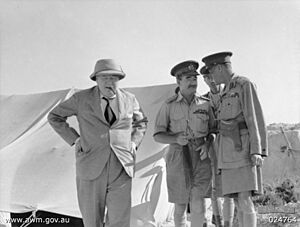
War with Japan started in December 1941. Many Australian divisions were sent to the Far East. In March 1942, Morshead was given command of all Australian forces in the Mediterranean. He was promoted to lieutenant general. He also remained commander of the 9th Division.
Morshead was one of the few Allied commanders with a record of success. He hoped to command a larger group of troops. But he was passed over for a British officer.
At the Second Battle of El Alamein, the 9th Division had a key role. They had to clear a path through German and Italian forces. They fought hard and broke through enemy lines. This battle was very costly for the 9th Division. But it forced Rommel's forces to retreat. A British general told Morshead that his division's "Homeric fighting" made the breakthrough possible. During this battle, 1,177 Australians were killed. Morshead received another mention in official reports. In November 1942, he received another knighthood.
New Guinea Campaign

After El Alamein, Morshead and the 9th Division were called back to Australia. Morshead arrived in Fremantle in February 1943. He then flew to Melbourne. There, he was told he would command a corps. In March 1943, Morshead became commander of II Corps. He handed over command of the 9th Division to another general.
Morshead's corps included the 6th, 7th, and 9th Divisions. They were training for jungle warfare in New Guinea. In October 1943, Morshead went to New Guinea. He took over command of the New Guinea Force. He faced a difficult situation. The Japanese were strong and planning a big attack. Morshead asked for more troops and tanks. The Japanese attack was defeated.
Morshead and his men had to learn jungle warfare. One officer noted that Morshead was used to large battles. Now, he was fighting a war where single enemy guns were big news.
In November 1943, Morshead became acting commander of New Guinea Force. This became permanent in January 1944. Morshead was in charge of forces in battles like Sattelberg and Sio. His hard work led to the capture of Madang in April 1944.
Borneo Campaign
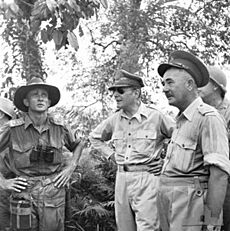
Morshead handed over command of New Guinea Force in May 1944. He returned to Australia and remained commander of the Second Army. Some people thought he had been "shelved." But he was actually considered to be the next commander-in-chief.
In July 1944, Morshead was appointed commander of I Corps. This corps would lead Australia's next operations. In February 1945, Morshead learned his target would be Borneo. General Douglas MacArthur placed I Corps directly under Morshead's command. Morshead had to make several landings on Borneo. These were at Tarakan, North Borneo, and Balikpapan. These operations were very successful. They achieved their goals with few losses.
The war ended before a plan to invade Japan was carried out. Morshead was considered for a command in that operation.
After the War
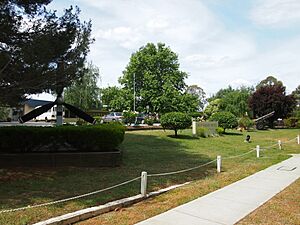
After the war, Morshead returned to civilian life. He became the Australian general manager for the Orient Steam Navigation Company in 1947. He continued to receive honours for his military service. These included another mention in official reports and the American Medal of Freedom.
He was also president of the Bank of New South Wales. He was chairman of David Jones. He was also a director of several other companies.
In his later life, Morshead turned down offers for military and diplomatic jobs. He also turned down the chance to be the governor of Queensland. He served as president of the Boy Scouts Association of New South Wales. He was also a trustee for a scholarship fund for veterans' families.
Morshead died of cancer on 26 September 1959 in Sydney. He had a military funeral. Former soldiers of the 9th Division came to pay their respects. He was survived by his wife and daughter.
Legacy and Memorials
Leslie Morshead is remembered in several ways. Morshead Drive in Canberra is named after him. It runs past the Royal Military College, Duntroon. In the Canberra suburb of Lyneham, there is the Morshead War Veterans Home. His portrait is held by the Australian War Memorial. His wartime papers are also there.
A memorial fountain for Morshead stands in Sydney. It is near the State Library of New South Wales. It is at the entrance to Sydney's Royal Botanic Gardens. The same architect designed it as the El Alamein Fountain in Kings Cross.
See also
 In Spanish: Leslie Morshead para niños
In Spanish: Leslie Morshead para niños


